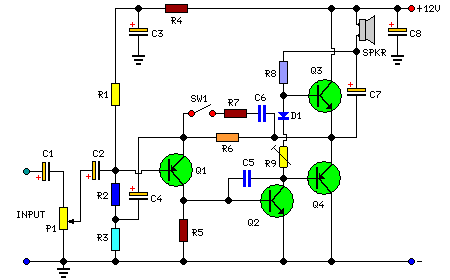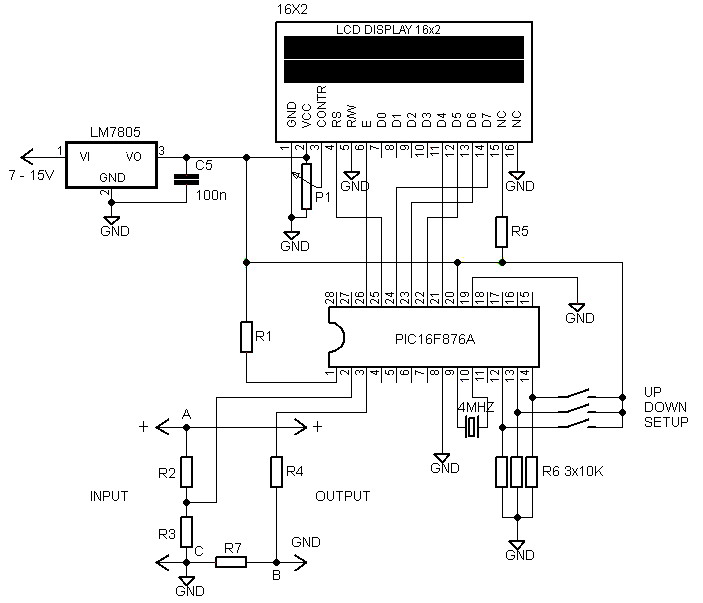
simple touch switch circuit

This project involves a simple touch switch circuit that can also be utilized to activate a relay instead of an LED and resistor. The circuit exhibits high sensitivity due to the use of two transistors configured as a Darlington pair. The first transistor amplifies the input signal, which is then further amplified by the second transistor, resulting in a significant increase in current gain. This high current gain allows the circuit to detect minimal current flowing through the skin, thereby activating the LED. The circuit can operate at voltages of 6, 9, and 12 volts; however, it is essential to use an appropriate LED current-limiting resistor in place of Rx. A 330-ohm resistor should be used for 6 volts, a 390-ohm resistor for 9 volts, and a 470-ohm resistor for 12 volts. The operation of the circuit is straightforward; both transistors function as switches. When the designated touch points are activated, a small current flows through the skin, completing the circuit and turning on the Darlington pair, which subsequently illuminates the LED.
The touch switch circuit primarily consists of two NPN transistors configured in a Darlington pair arrangement, which is known for its high current gain characteristics. The first transistor amplifies the input signal, while the second transistor further enhances this amplification, allowing the circuit to respond to very low input currents generated by the human body when a finger touches the designated points.
The circuit design includes a power supply that can accommodate 6, 9, or 12 volts, making it versatile for various applications. The selection of the current-limiting resistor is critical to ensure the LED operates within its safe current range. The resistor values are calculated based on the supply voltage to prevent LED damage while ensuring proper functionality.
In practical applications, the touch switch can be used to control various devices, including lights or relays, which can manage higher power loads. The sensitivity of the circuit can be adjusted by modifying the resistor values in the base circuit of the transistors or by changing the configuration of the Darlington pair.
The operation of the circuit is initiated when a user touches the touch points, which introduces a small current through the skin. This minute current is sufficient to turn on the Darlington pair, allowing a larger current to flow through the LED or relay, thus completing the switching action. This characteristic makes the touch switch circuit an excellent choice for applications requiring non-mechanical activation, such as in touch-sensitive lighting or as a part of a user interface in electronic devices.Here is a project of a simple touch switch circuit. This circuit and can also be used to activate a relay in the place of LED and resistor. The circuit is quite sensitive because we have used the two transistors as a Darlington pair. The gain is first amplified by the first transistor and then further amplified and multiplied by the second and so as a result we get a very high current gain. Due to high current gain the circuit can detect the very small current passing through our skin and activate the LED. The circuit can be operated with 6, 9 and 12 volts but make sure to use a proper LED current limiting resistor in the place of Rx.
Use 330 ohms resistor for 6 volts, 390 ohms for 9 volts and 470 ohms for 12 volts Working of the circuit is simple; both the transistors are working as a switch. When you touch the touching points of the circuit a very small current starts passing through our skin which completes the circuit due to which the Darlington pair becomes switched on and light up the LED.
🔗 External reference
The touch switch circuit primarily consists of two NPN transistors configured in a Darlington pair arrangement, which is known for its high current gain characteristics. The first transistor amplifies the input signal, while the second transistor further enhances this amplification, allowing the circuit to respond to very low input currents generated by the human body when a finger touches the designated points.
The circuit design includes a power supply that can accommodate 6, 9, or 12 volts, making it versatile for various applications. The selection of the current-limiting resistor is critical to ensure the LED operates within its safe current range. The resistor values are calculated based on the supply voltage to prevent LED damage while ensuring proper functionality.
In practical applications, the touch switch can be used to control various devices, including lights or relays, which can manage higher power loads. The sensitivity of the circuit can be adjusted by modifying the resistor values in the base circuit of the transistors or by changing the configuration of the Darlington pair.
The operation of the circuit is initiated when a user touches the touch points, which introduces a small current through the skin. This minute current is sufficient to turn on the Darlington pair, allowing a larger current to flow through the LED or relay, thus completing the switching action. This characteristic makes the touch switch circuit an excellent choice for applications requiring non-mechanical activation, such as in touch-sensitive lighting or as a part of a user interface in electronic devices.Here is a project of a simple touch switch circuit. This circuit and can also be used to activate a relay in the place of LED and resistor. The circuit is quite sensitive because we have used the two transistors as a Darlington pair. The gain is first amplified by the first transistor and then further amplified and multiplied by the second and so as a result we get a very high current gain. Due to high current gain the circuit can detect the very small current passing through our skin and activate the LED. The circuit can be operated with 6, 9 and 12 volts but make sure to use a proper LED current limiting resistor in the place of Rx.
Use 330 ohms resistor for 6 volts, 390 ohms for 9 volts and 470 ohms for 12 volts Working of the circuit is simple; both the transistors are working as a switch. When you touch the touching points of the circuit a very small current starts passing through our skin which completes the circuit due to which the Darlington pair becomes switched on and light up the LED.
🔗 External reference





